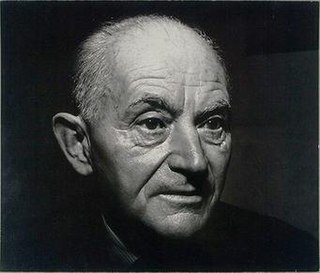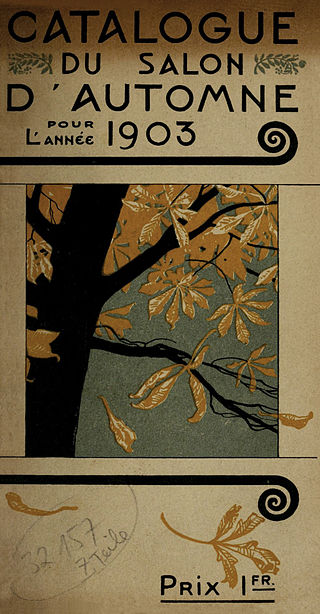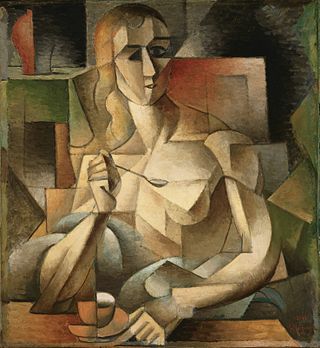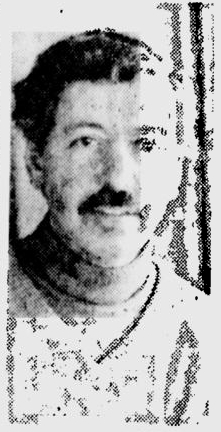Related Research Articles

Georges Braque was a major 20th-century French painter, collagist, draughtsman, printmaker and sculptor. His most notable contributions were in his alliance with Fauvism from 1905, and the role he played in the development of Cubism. Braque's work between 1908 and 1912 is closely associated with that of his colleague Pablo Picasso. Their respective Cubist works were indistinguishable for many years, yet the quiet nature of Braque was partially eclipsed by the fame and notoriety of Picasso.

Cubism is an early-20th-century avant-garde art movement that revolutionized European painting and sculpture, and inspired related artistic movements in music, literature, and architecture. In Cubist works of art, the subjects are analysed, broken up, and reassembled in an abstract form—instead of depicting objects from a single perspective, the artist depicts the subject from multiple perspectives to represent the subject in a greater context. Cubism has been considered the most influential art movement of the 20th century. The term cubism is broadly associated with a variety of artworks produced in Paris or near Paris (Puteaux) during the 1910s and throughout the 1920s.

Daniel-Henry Kahnweiler was a German-born art collector, and one of the most notable French art dealers of the 20th century. He became prominent as an art gallery owner in Paris beginning in 1907 and was among the first champions of Pablo Picasso, Georges Braque and the Cubist movement in art.

Modern art includes artistic work produced during the period extending roughly from the 1860s to the 1970s, and denotes the styles and philosophies of the art produced during that era. The term is usually associated with art in which the traditions of the past have been thrown aside in a spirit of experimentation. Modern artists experimented with new ways of seeing and with fresh ideas about the nature of materials and functions of art. A tendency away from the narrative, which was characteristic of the traditional arts, toward abstraction is characteristic of much modern art. More recent artistic production is often called contemporary art or postmodern art.

Jean Dominique Antony Metzinger was a major 20th-century French painter, theorist, writer, critic and poet, who along with Albert Gleizes wrote the first theoretical work on Cubism. His earliest works, from 1900 to 1904, were influenced by the neo-Impressionism of Georges Seurat and Henri-Edmond Cross. Between 1904 and 1907, Metzinger worked in the Divisionist and Fauvist styles with a strong Cézannian component, leading to some of the first proto-Cubist works.

The Salon d'Automne, or Société du Salon d'automne, is an art exhibition held annually in Paris. Since 2011, it is held on the Champs-Élysées, between the Grand Palais and the Petit Palais, in mid-October. The first Salon d'Automne was created in 1903 by Frantz Jourdain, with Hector Guimard, George Desvallières, Eugène Carrière, Félix Vallotton, Édouard Vuillard, Eugène Chigot and Maison Jansen.
Leonard Alan Lauder is an American billionaire, philanthropist, art collector. He and his brother, Ronald Lauder, are the sole heirs to the Estée Lauder Companies cosmetics fortune, founded by their parents, Estée Lauder and Joseph Lauder, in 1946. Having been its CEO until 1999, Lauder is the chairman emeritus of The Estée Lauder Companies Inc. During his tenure as the CEO, the company went public at The New York Stock Exchange in 1996 and acquired several major cosmetics brands, including MAC Cosmetics, Aveda, Bobbi Brown, and La Mer.

Les Demoiselles d'Avignon is a large oil painting created in 1907 by the Spanish artist Pablo Picasso. Part of the permanent collection of the Museum of Modern Art in New York, it portrays five nude female prostitutes in a brothel on Carrer d'Avinyó, a street in Barcelona, Spain. The figures are confrontational and not conventionally feminine, being rendered with angular and disjointed body shapes, some to a menacing degree. The far left figure exhibits facial features and dress of Egyptian or southern Asian style. The two adjacent figures are in an Iberian style of Picasso's Spain, while the two on the right have African mask-like features. Picasso said the ethnic primitivism evoked in these masks moved him to "liberate an utterly original artistic style of compelling, even savage force” leading him to add a shamanistic aspect to his project.

Czech Cubism was an avant-garde art movement of Czech proponents of Cubism, active mostly in Prague from 1912 to 1914. Prague was perhaps the most important center for Cubism outside Paris before the start of World War I.
William Stanley Rubin was an American art scholar, a distinguished curator, critic, collector, art historian and teacher of modern art.

Le Goûter, also known as Tea Time (Tea-Time), and Femme à la Cuillère is an oil painting created in 1911 by the French artist and theorist Jean Metzinger (1883–1956). It was exhibited in Paris at the Salon d'Automne of 1911, and the Salon de la Section d'Or, 1912.

Le Dépiquage des Moissons, also known as Harvest Threshing, and The Harvesters, is an immense oil painting created in 1912 by the French artist, theorist and writer Albert Gleizes (1881–1953). It was first revealed to the general public at the Salon de la Section d'Or, Galerie La Boétie in Paris, October 1912. This work, along with La Ville de Paris by Robert Delaunay, is the largest and most ambitious Cubist painting undertaken during the pre-War Cubist period. Formerly in the collection of the Solomon R. Guggenheim Museum in New York, this monumental painting by Gleizes is exhibited at the National Museum of Western Art, in Tokyo, Japan.

Proto-Cubism is an intermediary transition phase in the history of art chronologically extending from 1906 to 1910. Evidence suggests that the production of proto-Cubist paintings resulted from a wide-ranging series of experiments, circumstances, influences and conditions, rather than from one isolated static event, trajectory, artist or discourse. With its roots stemming from at least the late 19th century, this period is characterized by a move towards the radical geometrization of form and a reduction or limitation of the color palette. It is essentially the first experimental and exploratory phase of an art movement that would become altogether more extreme, known from the spring of 1911 as Cubism.

Léonce Rosenberg was an art collector, writer, publisher, and one of the most influential French art dealers of the 20th century. His greatest impact was as a supporter and promoter of the cubists, especially during World War I and in the years immediately after.

La Femme aux Phlox, also known as Woman with Phlox or Woman with Flowers, is an oil painting created in 1910 by the French artist and theorist Albert Gleizes (1881–1953). The painting was exhibited in Room 41 at the Salon des Indépendants in the Spring of 1911 ; the exhibition that introduced Cubism as a group manifestation to the general public for the first time. The complex collection of geometric masses in restrained colors exhibited in Room 41 created a scandal from which Cubism spread throughout Paris, France, Europe and the rest of the world. It was from the preview of the works by Gleizes, Jean Metzinger, Henri Le Fauconnier, Robert Delaunay, and Fernand Léger at the 1911 Indépendants that the term 'Cubism' can be dated. La Femme aux Phlox was again exhibited the following year at the Salon de la Section d'Or, Galerie La Boétie, 1912. La Femme aux Phlox was reproduced in The Cubist Painters, Aesthetic Meditations by Guillaume Apollinaire, published in 1913. The same year, the painting was again revealed to the general public, this time in the United States, at the International Exhibition of Modern Art, New York, Chicago, and Boston. The work is now in the Museum of Fine Arts, Houston, Gift of the Esther Florence Whinery Goodrich Foundation in 1965.

Passy, Bridges of Paris, also called Les ponts de Paris (Passy), or Paysage à Passy, is a painting created in 1912 by the French artist, theorist and writer Albert Gleizes. The work was exhibited at the Salon de la Société Normande de Peinture Moderne, Rouen, 1912 (titled Passy); the Salon de la Section d'Or, Galerie La Boétie, Paris, 1912 (titled Passy); Manes Moderni Umeni, Vystava, Prague, 1914 (titled Paysage à Passy); and Galerie Der Sturm, Berlin, July, 1914.

Daniel J. Robbins was an American art historian, art critic, and curator, who specialized in avant-garde 20th-century art and helped encourage the study of it. Robbins' area of scholarship was on the theoretical and philosophical origins of Cubism. His writings centered on the importance of artists such as Albert Gleizes, Jean Metzinger, Henri Le Fauconnier and Jacques Villon. He was a specialist in early Modernism, writing on Salon Cubists and championed contemporaries such as Louise Bourgeois and the Color Field painters. Art historian Peter Brooke referred to Robbins as "the great pioneer of the broader history of Cubism".

Les Peintres Cubistes, Méditations Esthétiques, is a book written by Guillaume Apollinaire between 1905 and 1912, published in 1913. This was the third major text on Cubism; following Du "Cubisme" by Albert Gleizes and Jean Metzinger (1912); and André Salmon, Histoire anecdotique du cubisme (1912).

Crystal Cubism is a distilled form of Cubism consistent with a shift, between 1915 and 1916, towards a strong emphasis on flat surface activity and large overlapping geometric planes. The primacy of the underlying geometric structure, rooted in the abstract, controls practically all of the elements of the artwork.
Bernice Harriet Rose was an American art historian and curator.
References
- ↑ Braun, Emily (16 January 2018). "Emily Braun- Department of Art and Art History". Department of Art and Art History - Hunter College, City University of New York. Retrieved April 6, 2022.
- ↑ "Cubism | Yale University Press". yalebooks.yale.edu.
- ↑ Maloney, Jennifer (May 23, 2013). "The Secret Behind Lauder's Gift". Wall Street Journal– via www.wsj.com.
- 1 2 3 "Emily Braun, The Center for the Humanities". Center for the Humanities, The Graduate Center, City University of New York. Retrieved April 6, 2022.
- ↑ Wohl, Robert. "Heart of Darkness: Modernism and Its Historians." The Journal of Modern History 74, no. 3 (2002): 573-621. Accessed May 3, 2020. doi:10.1086/345112.
- ↑ "The Leonard A. Lauder Research Center for Modern Art". The Metropolitan Museum of Art. Retrieved 2022-04-06.
- ↑ "The Dedalus Foundation". www.dedalusfoundation.org.
- ↑ Mishan, Ligaya (June 22, 2015). "Emily Braun's Birds Guide Guests to Their Perches". The New York Times.
- ↑ Vogel, Carol (October 10, 2014). "A Collector's Personal Perspective". The New York Times.
- ↑ Vogel, Carol (April 9, 2013). "A Billion-Dollar Gift Gives the Met a New Perspective (Cubist)". The New York Times.